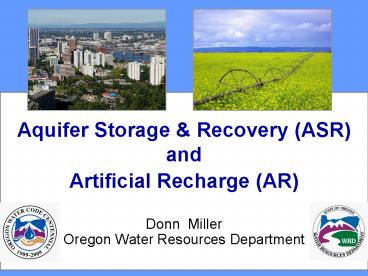Aquifer Storage - PowerPoint PPT Presentation
1 / 24
Title:
Aquifer Storage
Description:
Recharge water must meet drinking-water standards ... Seepage systems, Injection wells. Recharge Method. Primarily drinking water. Primarily irrigation ... – PowerPoint PPT presentation
Number of Views:56
Avg rating:3.0/5.0
Title: Aquifer Storage
1
Aquifer Storage Recovery (ASR) andArtificial
Recharge (AR)
- Donn Miller
- Oregon Water Resources Department
2
Key Differences between AR ASR
3
Key Differences between AR ASR
4
Generalized Application Process for AR ASR
Pre-Application Conference arranged by WRD with
DHS, DEQ, DFW and applicant
Submit application supplemental reports to WRD
WRD issues authorization conditioned by all
agencies
Operation monitoring and reporting to agencies
Apply for additional authorization as needed
5
Oregon Experience with Groundwater Storage Case
Studies
6
Status of ASR AR in Oregon
- Active ASR sites 11
- Active AR sites 5
7
Oregon Experience Case Studies
8
County Line AR Umatilla/Morrow Counties
- Canal recharge began in 1977
- Recharges an average of 6,000 ac-ft/year
- Augments Ordnance Critical Area gravel aquifer
for irrigation - Source water Umatilla River
9
Salem ASR Marion County
- The City began ASR in 1997
- Stores up to 500 Million Gallons/year
- Source Water North Santiam River
- Columbia River Basalt aquifer
10
New Oregon Activities
- OWSCI Oregon Water Supply and Conservation
Initiative - Feasibility Studies Water Conservation, Reuse
and Storage Grant Program - Research Umatilla Basin Groundwater Storage
11
Conclusions
- Oregon has 2 administrative options ASR AR
- There are 16 active Groundwater Storage sites
- The State of Oregon is currently sponsoring 3
Groundwater Storage Activities
www.wrd.state.or.us
12
Feasibility Considerations forAquifer Storage
Recovery (ASR) andArtificial Recharge (AR)
- Tom Pattee
- Oregon Department of Human Services
13
What Kinds of Questions Should Interested
Communities Ask?
- What are our future water needs?
- Is water available for underground storage?
- Do we have a suitable hydrogeologic setting for
underground storage? - Are the appropriate water rights in place?
- What are the analysis and implementation costs?
14
Feasibility What are our future water needs?
- How will population change affect need?
Percent Change
-4.5 to 0.1
0.1 to 2.5
2.6 to 8.5
8.6 to 15.0
15.0 to 39.5
The U.S. Census Bureau projects a population
increase of one million people in Oregon by 2030.
15
Feasibility What are our future water needs?
- How will climate change effect water supply?
- Planning community water system master plan
16
Feasibility Water Availability in Oregon
- In general, there is more water available
during the winter months than in summer months,
when demand is highest.
17
Feasibility What Hydrogeologic Features
Influence Suitability?
- Ability of the aquifer to accept water
- Ability to retain water
- Sufficient storage to reach economy of scale
- Favorable aquifer boundary conditions
18
Feasibility Cost vs. Benefit
- Costs are lower than for surface reservoirs
- Few environmental impacts
- Minimal land requirements
- Lower construction costs
19
Feasibility Cost vs. Benefit
- But nothing is free Must factor in costs of
- Feasibility Study site characterization and
monitoring - Water treatment filtration and disinfection
- Infrastructure improvements pumping systems,
pipes, wells - Ongoing maintenance and monitoring
20
Feasibility Infrastructure
- Water treatment (esp. for ASR) and/or water
quality monitoring equipment - Canals and pipelines to move water from source to
recharge site - Monitoring wells upgradient and downgradient of
recharge site
21
Feasibility Water Quality Concerns
- Must meet water quality standards before
recharge, during storage and at time of recovery - Source water and ambient groundwater must be
compatible
22
Conclusions
- Considerations for the feasibility of ASR and AR
include - Water Needs
- Water Availability for Storage
- Suitable Hydrogeologic Setting
- Water Rights
- Costs of Analysis and Implementation
23
Feasibility Groundwater Quality Protection Rules
- Anti-degradation Policy
- This DEQ policy emphasizes the prevention of
groundwater pollution and control of waste
discharges so that the highest possible
groundwater quality is preserved. - New DEQ permitted facilities are not allowed to
increase contaminants above background
concentrations without a variance.
24
Feasibility Groundwater Quality Protection
- AR Source water must meet water quality standards
as specified in DEQs groundwater rules. - ASR Source water must meet drinking water
standards specified by DHS rules. - Source water and ambient groundwater must be
compatible.































